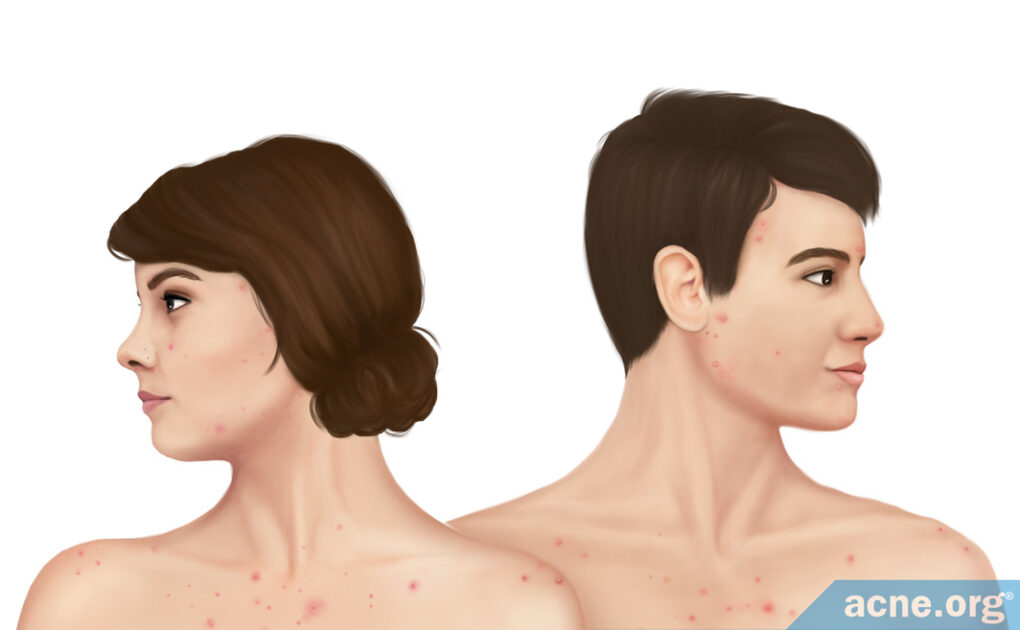Adult Acne Affects Men and Women, but Especially Women, and Can Present Differently than Adolescent Acne

The Essential Info
Adult acne is usually defined as acne that affects people over the age of 25.
In about 1/2 of cases, acne ends after adolescence (around 18 – 20). For the other 1/2, it continues into adulthood. For a minority of people, particularly women, acne can subside after adolescence and then make a resurgence in adulthood.
Causes of Adult Acne in Men: Exactly why acne continues in men is not fully understood, but normally it is as simple as “it hasn’t gone away yet.” That means, just like what caused acne in the first place, it is a potential combination of:
- Hormones: Higher levels of testosterone and other male hormones, and/or higher sensitivity to these hormones lead to more acne.
- Genetics: If your father or mother also had adult acne, your chances go up.
- Physical irritation of the skin: Wearing a face mask for a sport or frequently wearing a baseball hat are two examples of physically irritating the skin that could keep a man in a cycle of acne. Even constantly touching the skin can aggravate acne.
- Stress, smoking: Medical evidence at this point shows us that when the body is chronically attacked with stress or with harmful substances, It has a harder time keeping its organs in top shape. The skin is the body’s largest organ, so while the evidence regarding stress, smoking, and acne is not yet overwhelming, replicated, and completely understood, it makes common sense that chronic negative assaults to the body could lead to more acne.
Treatment of Adult Acne in Men: Treating acne with a proper benzoyl peroxide regimen can keep the vast majority of men clear. However, in some cases of severe, widespread (particularly if on large areas of the body), and scarring acne, isotretinoin (Accutane®) is an option that can be carefully and soberly considered.
Causes of Adult Acne in Women: While girls as a whole have less acne than boys, this balance flips in adulthood, with more women struggling with adult acne after the age of 25. This is thought to be because of the fluctuating hormones during the menstrual cycle, but may also be due to:
- Genetics: If your mother or father also had adult acne, you are also more likely to struggle with it.
- Physical irritation of the skin: Wearing a face mask for a sport or wearing a lot of makeup, particularly if you apply it or remove it roughly, are 2 examples of physically irritating the skin that make it much harder for a woman to stay clear. Even constantly touching the skin with your hands or hair, especially when you are using potentially pore-clogging hair products, can aggravate acne.
- Stress, smoking: Medical evidence at this point shows us that when anyone’s body is chronically attacked with stress or with harmful substances, it has a harder time keeping its organs in top shape. Based on the research that has been produced so far, when it comes to the body’s largest organ–the skin–and when we look at acne in particular, women may be more susceptible to both stress and smoking when compared to men.
Treatment of Adult Acne in Women: Treating acne with a proper benzoyl peroxide regimen can keep the vast majority of women clear, even through the hormonal roller coaster a menstrual cycle entails. However, when blood tests show a hormonal imbalance, particularly when levels of androgens (male hormones) are overly elevated, hormonal treatment, including oral contraceptives (the birth control pill) and/or anti-androgens, can be the treatment of choice. In some cases of very severe and scarring acne, a last resort option is isotretinoin (Accutane®), an oral medication that comes with many side effects–some of which can be lifelong–but can clear acne in extreme cases. Isotretinoin is the #1 birth defect-causing medication on the market. Consider it only if under the supervision of an experienced physician, and if it is taken, always use at least two (2) forms of responsible and dependable birth control. And as with any medication that permanently changes the body, have your eyes open to potentially long-term side effects.

The Science
- The Three Types of Adult Acne
- Causes of Adult Acne
- Adult Acne Vs. Adolescent Acne
- What Studies Tell Us
- Conclusion
People often think of acne as a condition that affects teenagers that disappears naturally after adolescence, but different studies have shown that significant percentages of adults experience acne as well. Adult acne is normally defined as acne in persons 25 years of age or older.1
The Three Types of Adult Acne
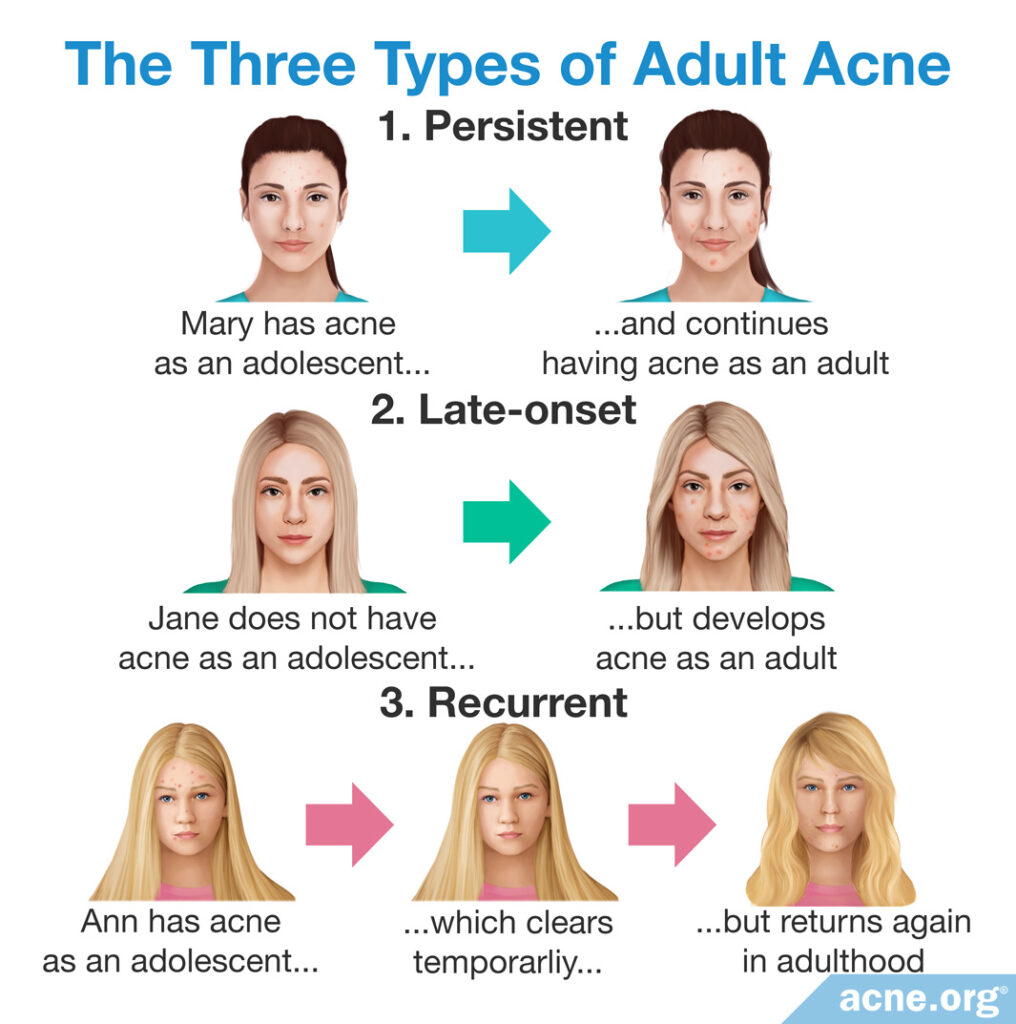
There are three types of adult acne.
- Persistent acne begins during adolescence and continues into adulthood.
- Late-onset acne begins during adulthood, affecting people who did not suffer from acne during adolescence.
- Recurrent acne begins during adolescence, then goes away temporarily only to make a comeback at some point in adulthood.1,2
Causes of Adult Acne
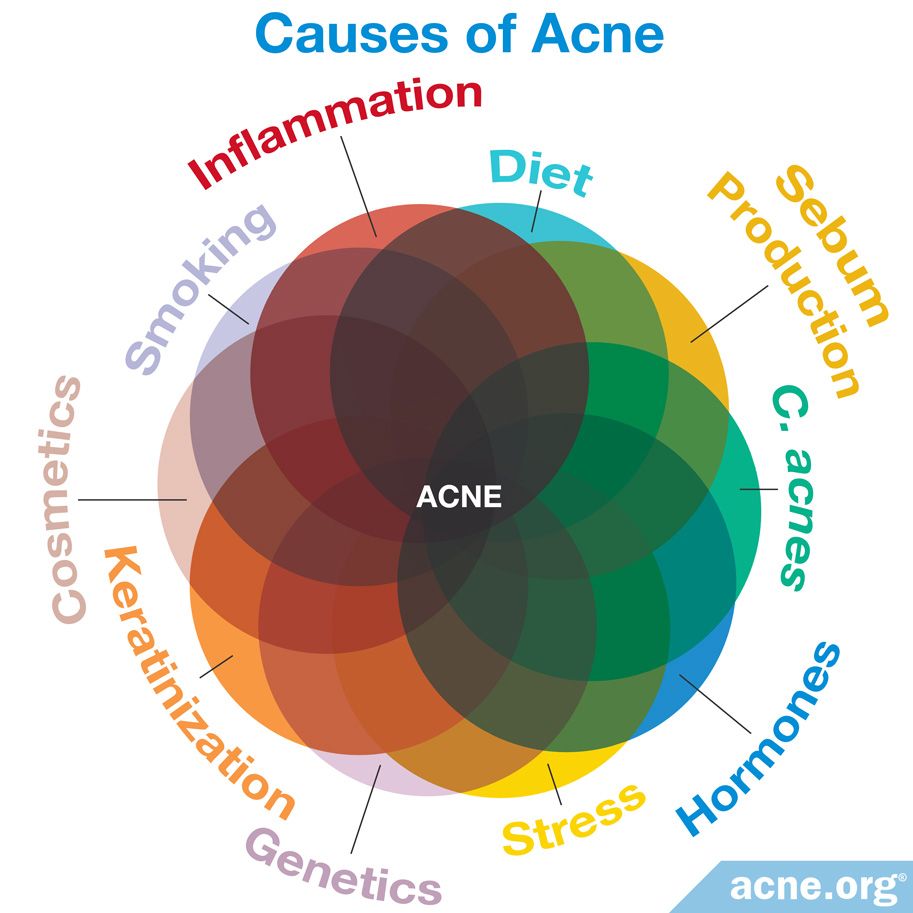
Although the underlying causes of adult acne have not been completely investigated, researchers in a 2006 report published in the American Journal of Clinical Dermatology claim that many of the same biological processes and other factors related to adolescent acne likely play a role in adult acne:

“…no clear causes for the clinical difference between adult and adolescent acne have been delineated, although [hormone] abnormality, genetic predisposition, antibiotic resistant [acne bacteria], cosmetics, smoking, and emotional stress are regarded as potential risk factors for the development of adult acne.”3
Let’s look at the potential causes of adult acne in layman’s terms and look at what each entails.
Hormone (endocrine) imbalance: Acne is generally caused by an imbalance of hormones, which are produced by the endocrine system. Androgens, which are male hormones that are also present in females to a lesser degree, are primarily responsible for triggering acne. The increased production of androgens contributes to the following events, which work together to cause acne:
- Increased skin oil (sebum) production in the pores
- Skin cell overproduction (keratinization)
- Overgrowth of acne bacteria (C. acnes)
- Inflammation3-5
Genetic predisposition (genes): If a person’s parents suffer from a certain disease, he is more likely to develop that disease. In the case of adult acne, people who have relatives or a family history of adult acne are more likely to deal with adult acne as well. However, studies on twins have revealed that, in addition to genetics, environmental factors can also contribute.6-8
Cosmetics and skincare products: Some products contain pore-clogging ingredients. Dermatologists refer to products that tend to clog pores as “comedogenic.”3
Emotional stress: It has not been proven, but some researchers believe that stress affects how the immune system responds to infections, including infections by C. acnes. Stress may also affect how the body regulates hormones, which may trigger acne.3
Smoking: Not everyone in the acne research community agrees that smoking causes acne. Some studies support this idea, and some do not. However, some researchers have suggested that smoking may result in acne by altering the composition of skin oil (sebum).9-11
Diet: Diet and acne is an area of ongoing research, and thus far we can hesitantly state that a high-glycemic diet, which is a diet that contains a lot of high-sugar and processed foods, may lead to more acne, but we will have to see better studies done on this topic before we can say for certain.12
Adolescent Acne Vs. Adult Acne
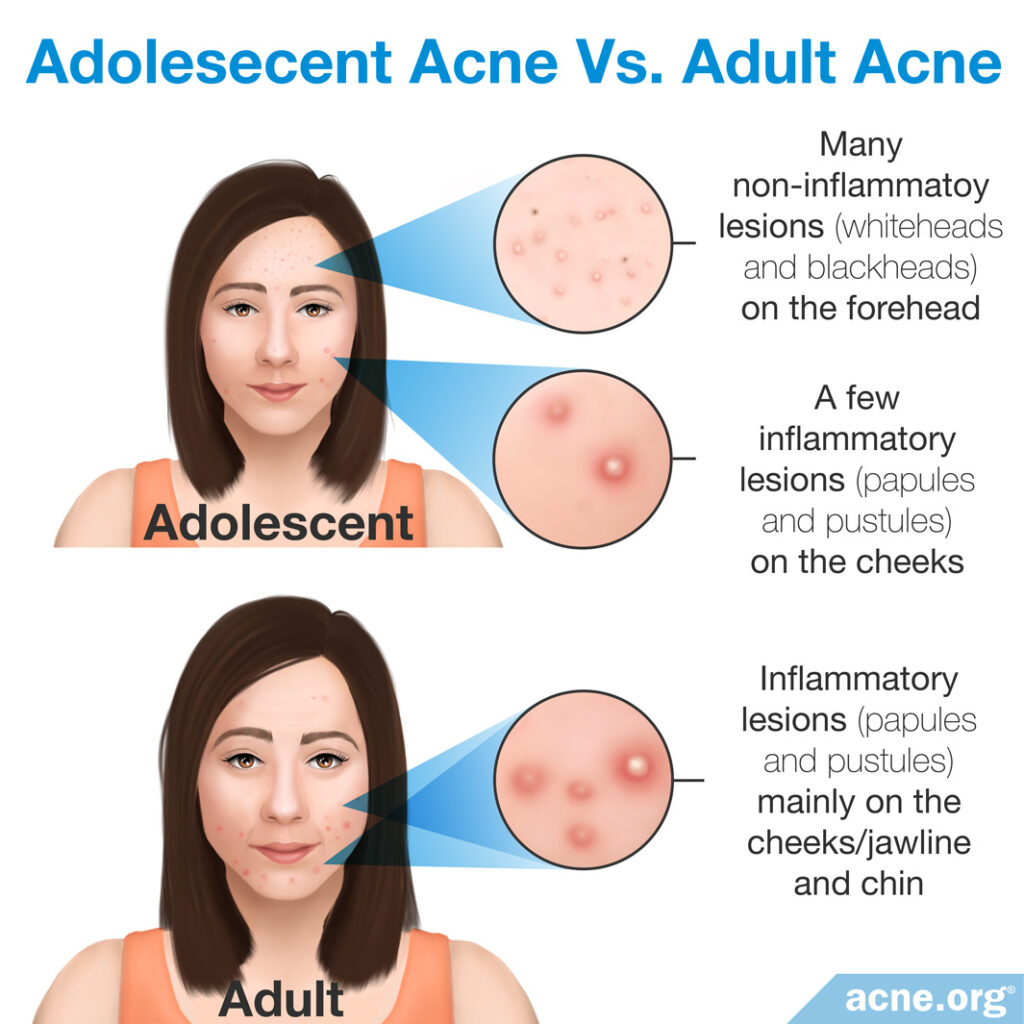
There are some notable differences in how acne affects adults compared to adolescents.
- Adult acne tends to affect women more than men, whereas adolescent acne affects boys more than girls.
- Adults with acne tend to get fewer non-inflamed comedones (clogged pores) than adolescents with acne, whereas adult acne can produce more inflamed pimples. Consequently, adult acne leads to scarring more often than adolescent acne.1
- Both adult and adolescent acne can affect the face, neck, and torso. Several studies have demonstrated that adult acne is particularly present on areas near the cheeks, chin, and mandible (jaw) in both men and women.1,13-16
The differences in features of adolescent and adult acne are organized in the table below:
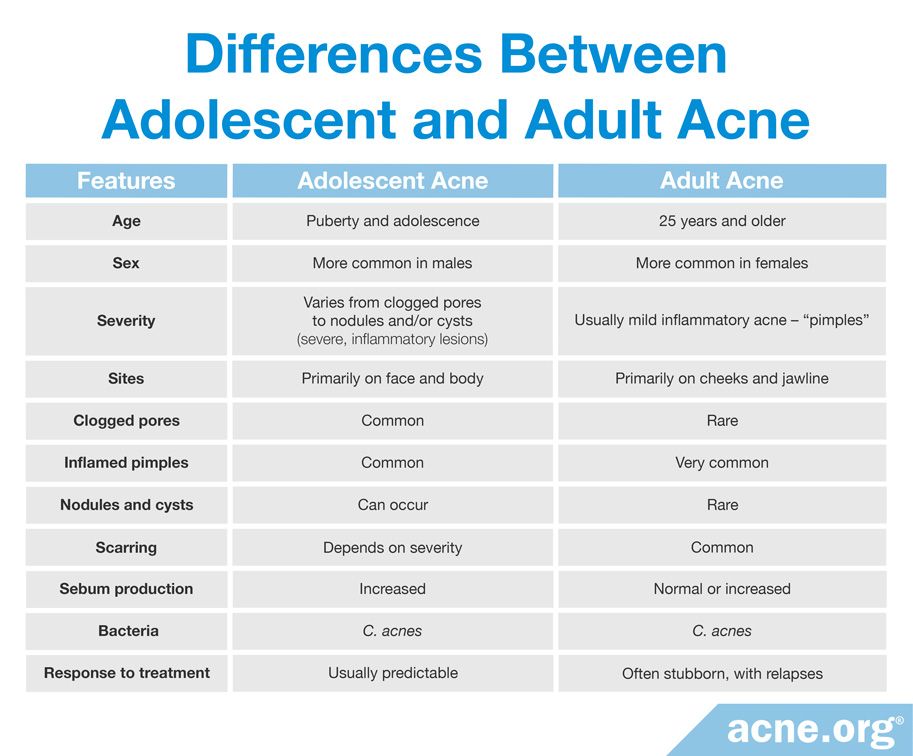
The next table shows us how males experience more adolescent acne while females experience more adult acne:
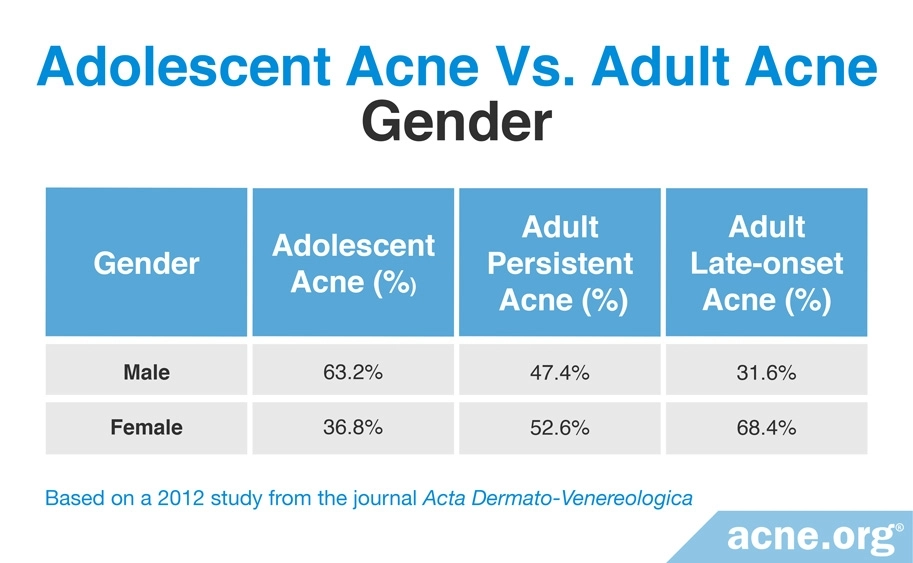
And next, we see something a little surprising–that both adolescent and adult acne are not too different when it comes to severity:
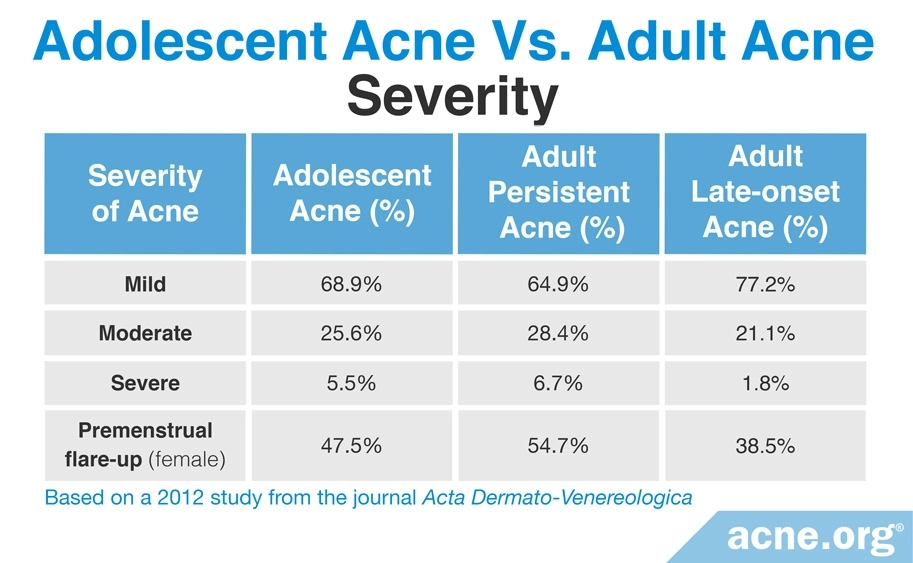
What Studies Can Tell Us about Adult Acne
Although there is much that researchers don’t understand about adult acne, scientific studies have been able to provide answers to some questions. The table below summarizes answers to some of these questions, based on the best research that is currently available. Details about the studies are explained further in this article.
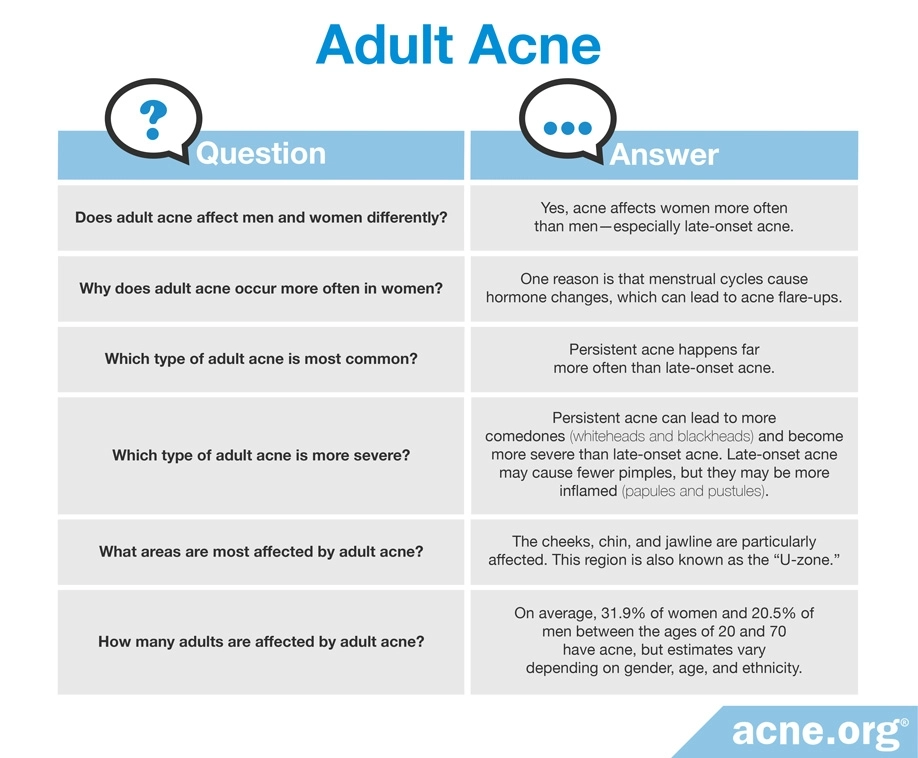
Let’s delve into some studies now and see what they can tell us about some specifics.
Acne declines with age
A large study looked at how often acne occurred in different age groups, and thankfully we can see that acne declines with age. The results of this comparison are shown in this table:14
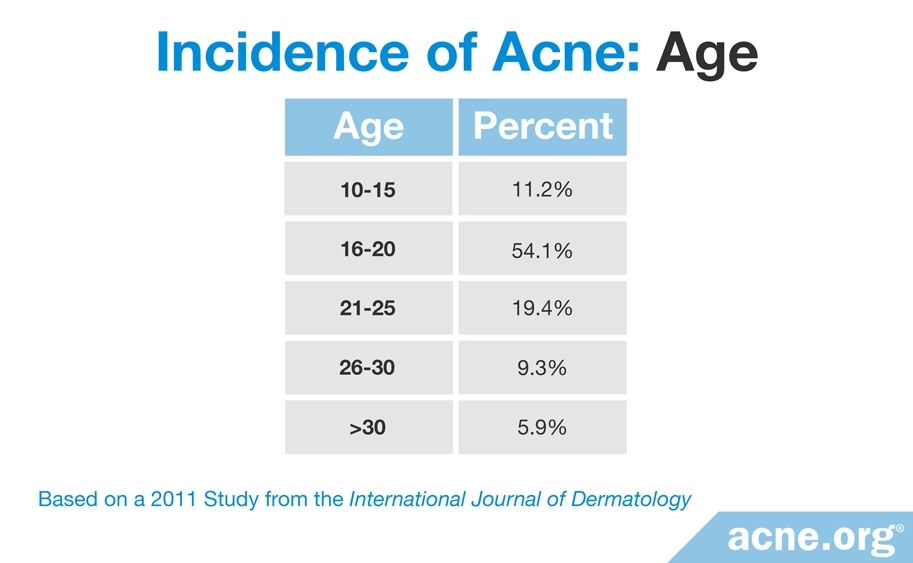
Women are more likely to experience adult acne
Research shows that adult acne in general is more common in women than in men.17,18
In addition, 2 large studies have shown that late-onset acne specifically is much more common in women than in men.1,14
Expand to read details of studies

In a 2012 study published in the Indian Journal of Dermatology, Venereology and Leprology, there was clear evidence that women are more affected by late-onset acne than men. The study included 280 adults with acne, 230 of which were women, and 50 were men. The participants were over 25 years of age, with the average age being 30.5 years. Late-onset acne was experienced by 26.8% of the participants. This group included mostly women – 73 females, compared to only 2 males. The other 73.2% of participants experienced persistent acne – a group that included 160 females and 45 males. The severity of acne was mostly moderate among males and females, and both genders also had similar types of acne.1

The tendency for adult acne to affect women more than men was also shown in a 2011 study in the International Journal of Dermatology, which also looked at how acne affected different age groups. This study included 225 female and 320 male participants with acne. The average age of the female participants was 24.5 years, and the average age of the males was 23.1 years. The results showed that females over the age of 30 were far more likely to have adult acne than males over the age of 30. Acne was most prevalent in the adolescent age groups, and less prevalent in the adult age groups.14
Since women experience more adult acne, let’s zero in on the potential contributing factors to adult female acne and see what studies can tell us about this topic.
Adult female acne may result from a combination of factors
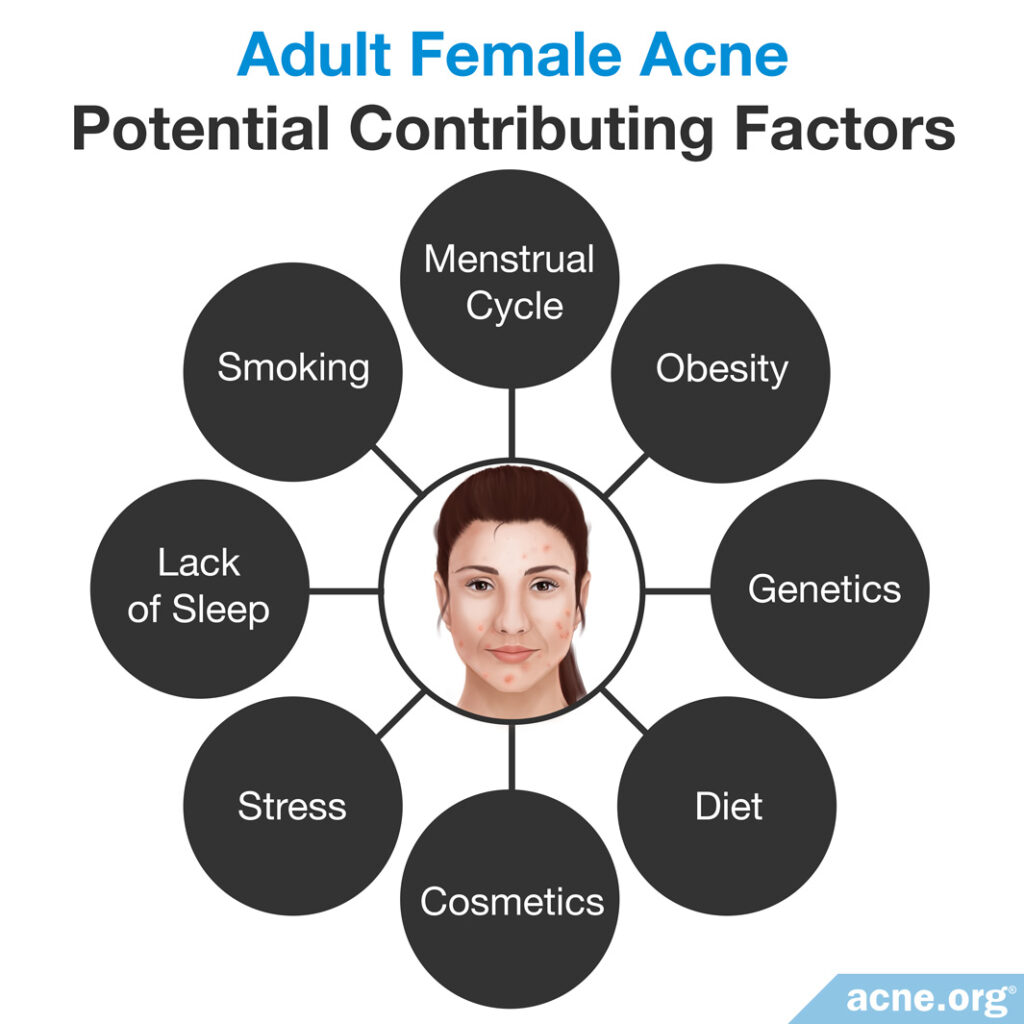
The first, and most clear reason that women may experience more adult acne than men is because women go through a monthly menstrual cycle. The cycles cause changes in androgen levels, which are related to premenstrual flares of acne (7 – 10 days before menstruation begins) in adolescents as well as adult females.
A recent study found that about a third of women with adult acne have abnormally high androgen levels.19 Excessive amounts of androgens at certain points during the menstrual cycle may be one of the factors contributing to adult female acne.
Expand to read details of study
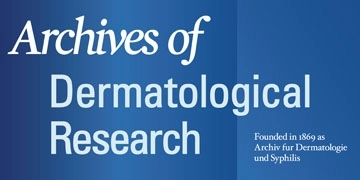
A 2014 study in the journal Archives of Dermatological Research reported that among 28 female participants with adult acne, 37% also possessed excess amounts of androgens.19 As we have already discussed, excess androgens can set in motion other factors that trigger acne, such as overproduction of skin oil and overgrowth of acne bacteria.
Continuing with the topic of hormones, women may also develop adult acne due to polycystic ovary syndrome (PCOS), a disorder in which hormone levels are unbalanced, cysts are found on the ovaries, menstrual cycles become disrupted, and hair growth may increase. One recent study suggests that women with PCOS are more prone to persistent acne than late-onset acne. In other words, PCOS tends to cause acne in adolescence that continues on into adulthood.20
Expand to read details of study

A 2020 study published in the International Journal of Dermatology looked at hormone levels in 120 women with adult acne. Almost half (44%) of the women with persistent acne suffered from PCOS, compared to only 8% of women with late-onset acne. The study did not include any women with recurrent acne.20
One factor unrelated to hormones that may contribute to acne in adult women is antibiotic-resistant C. acnes bacteria. Scientists suspect that the ongoing presence of these bacteria causes the immune system to be overactive, resulting in inflammation and inflammatory acne lesions.17,21 This factor might also play a role in acne in adult men–more research is needed to know for sure.
Persistent acne is more common than late-onset acne, and may be more severe
Adults who experience acne are far more likely to have persistent acne, rather than the late-onset variety. We have evidence of this from a large 2012 study that included nearly 1400 participants. This study found that among people with adult acne, over 80% suffer from persistent acne, and that persistent acne tends to be slightly more severe than late-onset acne. The researchers also concluded that adult acne is most common in people who are in their late 20s, and that acne incidence decreases in the following decades.1
Expand to read details of study

This was shown in a 2012 study published in the journal Acta Dermato-Venereologica. The study included 1399 participants of all ages who had acne, both male and female. Adult acne affected 25.7% of the participants in the study. Of these adults, 83.3% had persistent acne, and the other 16.7% had late-onset acne. The researchers found that adult acne was most prevalent in people during their late 20s, with a decrease in the decades that followed. Other data from the study showed the following:1
- Persistent acne cases were slightly more severe than late-onset acne
- Persistent acne resulted in more premenstrual flares than late-onset acne
- Women are affected by late-onset acne more than men
Another study confirmed the finding that persistent acne is more common than late-onset acne, and again, found that late-onset acne is more likely to strike women than men.1
Expand to read details of study

The previously mentioned 2012 study from the Indian Journal of Dermatology, Venereology and Leprology also showed that persistent acne was more common than late-onset acne, and late-onset acne affected women more than men.1
The cheeks, chin, and jaw areas are most prone to adult acne
While adolescent and adult acne both affect the face, research shows that adult acne is particularly common on the cheeks, chin, and jawline.1,17
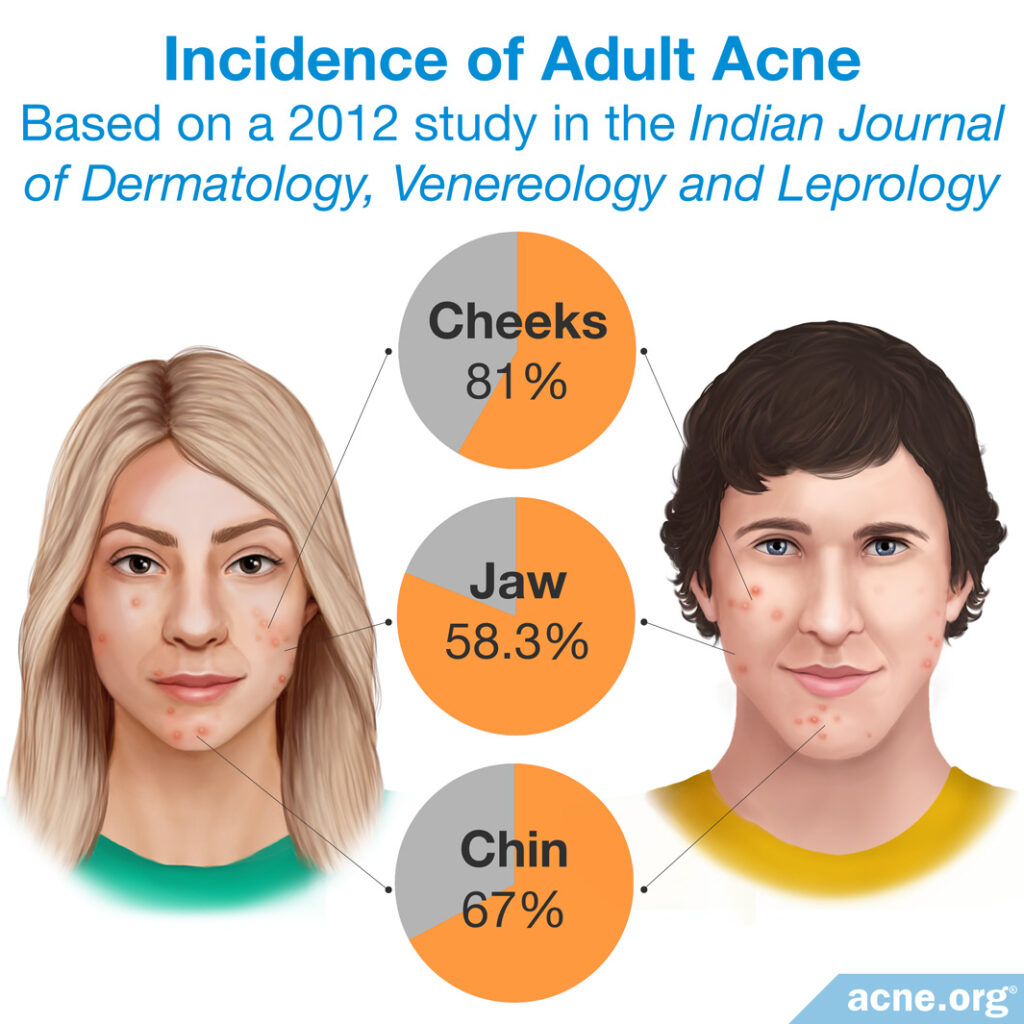
Expand to read details of research

In the previously mentioned 2012 study published in the Indian Journal of Dermatology, Venereology and Leprology, researchers recorded where acne occurred among the 280 male and female adult participants, and found that:1
- 81% of the participants had acne on the cheeks
- 67% of the participants had acne on the chin
- 58.3% of the participants had acne on the jaw area

The authors of an overview article published in the journal Experimental and Therapeutic Medicine in 2022 described the typical pattern of acne in adult women as a “surgical mask” pattern, mainly affecting the jaw, chin, and the skin around the mouth.17
The graph below shows the similarities and differences in how men and women with adult acne experienced acne on the U-zone as well as on the T-zone, which comprises forehead and nose areas.1
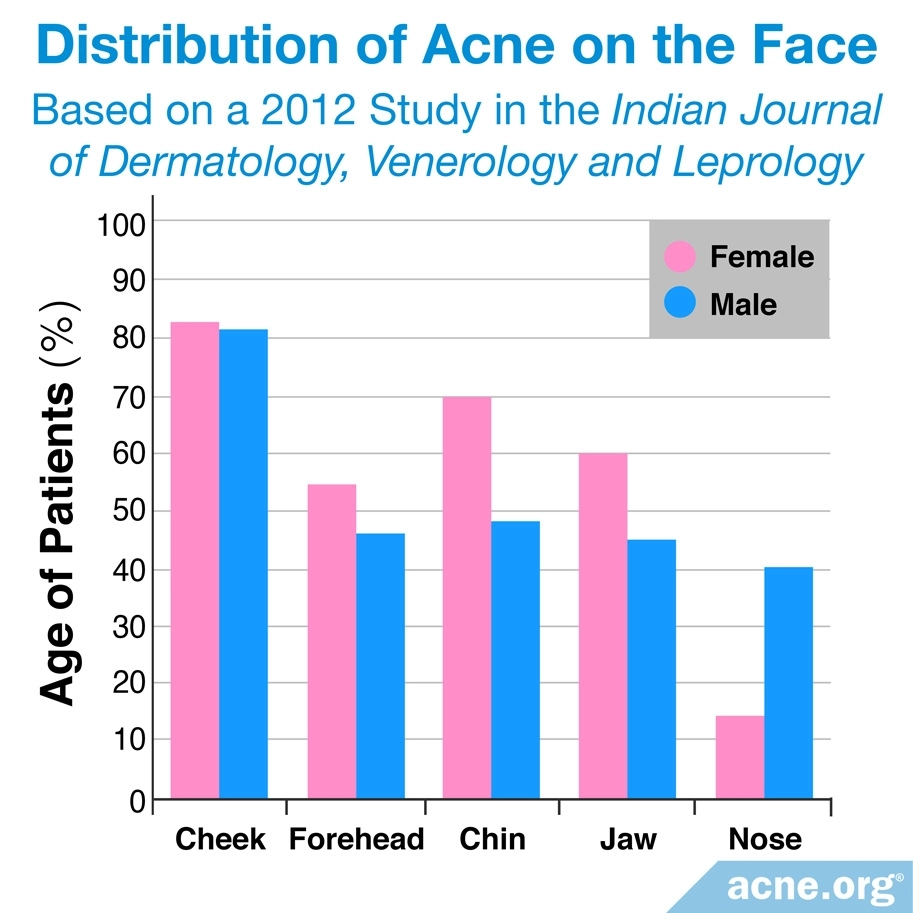
Late-onset acne causes fewer comedones, but more inflammation than persistent acne
A study that looked at women with adult acne found that women suffering from late-onset acne had fewer acne lesions than women with persistent acne. However, the researchers also observed that lesions in late-onset acne were more inflamed or swollen compared to lesions in persistent acne.16
Expand to read details of study

A 2011 study published in the Journal of the European Academy of Dermatology and Venereology focused on the differences between persistent and late-onset adult acne in women. The study showed that late-onset acne was generally less severe and presented fewer comedones than persistent acne. This study included 89 female participants with adult acne and distinguished them based on the age at which their acne began. Researchers defined late-onset acne as acne occurring after the age of 21. Cases of acne that started before 21 years of age were considered persistent adult acne. The results showed that women with late-onset acne had fewer lesions, but those lesions were more inflamed or swollen. This study also provided more data showing that adult acne is likely to occur on the U-zone, while adolescent acne may be more likely to occur on the T-zone. The researchers also found that the levels of C. acnes and sebum production in the skin were similar in both late-onset and persistent adult acne types.16
The proportion of adults who have acne varies widely
A variety of acne studies conducted on groups of people in different countries reported incidences of adult acne. The following table summarizes the findings, and how they are categorized. There is some variation in how prevalent acne is, depending on gender, age, and ethnicity. Because of these variations, it is difficult to estimate how often adult acne that would be true for all adults occurs. But generally, I estimate that 31.9% of women and 20.5% of men between the ages of 20 and 70 years old are affected by acne, based on these studies.
Here are the study-results on how genders are affected by adult acne:22-26
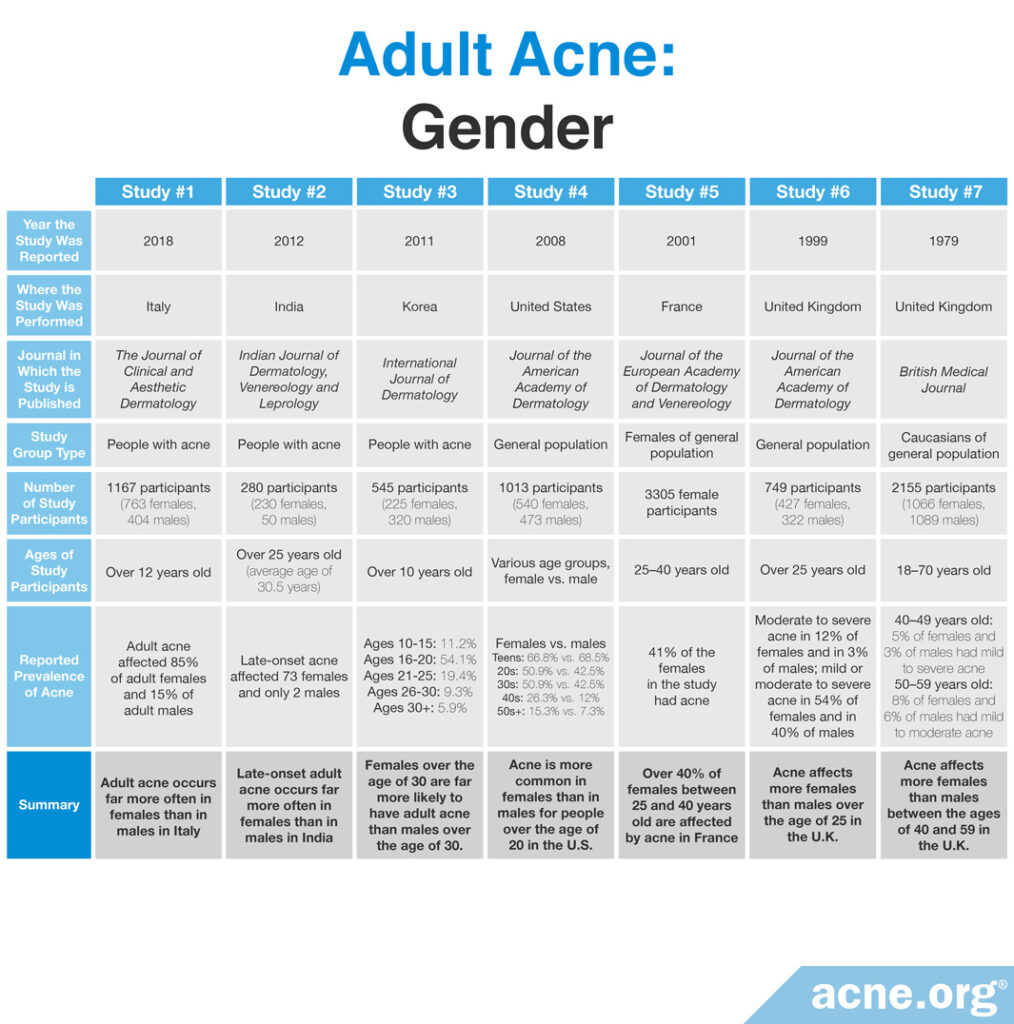
Next, here are study-results on how the frequency of adult acne diminishes with age:23,27
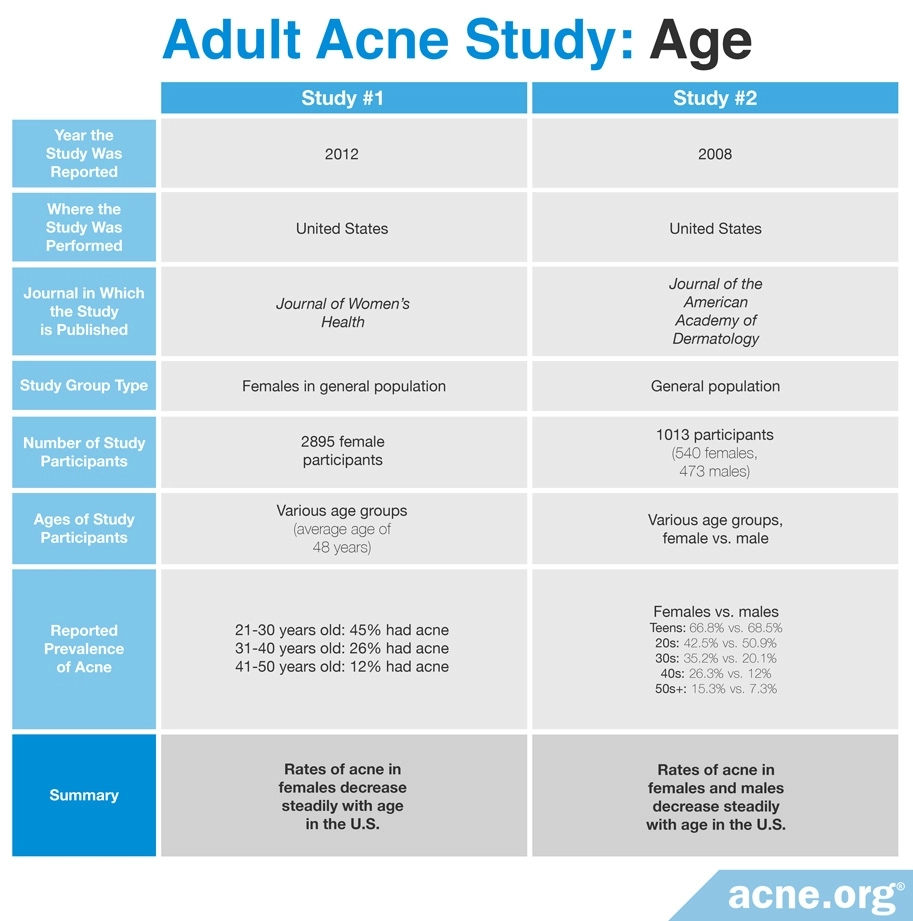
And finally, here are study results on how often adult acne occurs in different ethnicities:28-30
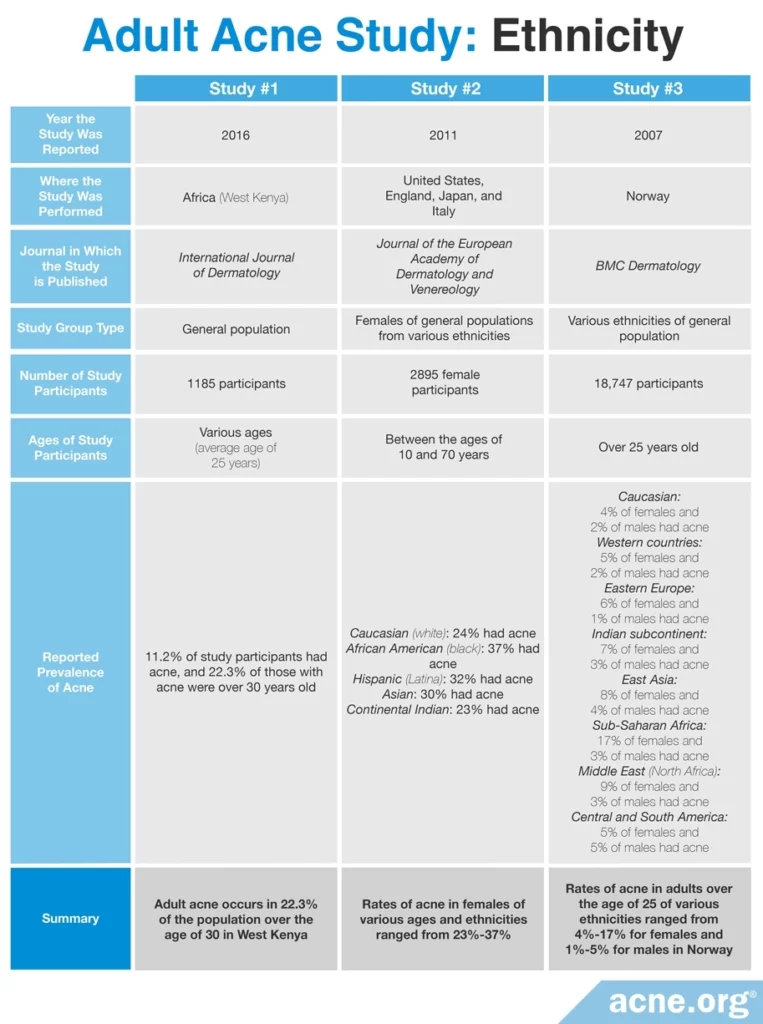
Conclusion
Adult acne is caused by the same factors as adolescent acne, but there are some notable differences in how it presents. Persistent adult acne is far more common than late-onset adult acne. Late-onset adult acne tends to affect women more than men, but adult acne in general is particularly common on the cheeks, chin, and jawline. In these regions, fewer comedones but more inflammation are seen than in adolescent acne.
References
- Khunger, N. & Kumar, C. A clinico-epidemiological study of adult acne: Is it different from adolescent acne? Indian J. Dermatol. Venereol. Leprol. 78, 335 (2012). https://www.ncbi.nlm.nih.gov/pubmed/22565434
- Rocha, M. A. & Bagatin, E. Adult-onset acne: prevalence, impact, and management challenges. Clin. Cosmet. Investig. Dermatol. 11, 59-69 (2018). https://pubmed.ncbi.nlm.nih.gov/29440921/
- Williams, C. & Layton, A. M. Persistent acne in women implications for the patient and for therapy. Am. J. Clin. Dermatol. 7, 281 – 290 (2006). https://www.ncbi.nlm.nih.gov/pubmed/17007539
- Dawson, A. L. & Dellavalle, R. P. Acne vulgaris. BMJ 2634, 1 – 7 (2013). https://www.ncbi.nlm.nih.gov/pubmed/23657180
- Tom, W. L. & Barrio, V. R. New insights into adolescent acne. Curr. Opin. Pediatr. 20, 436 – 440 (2008). https://europepmc.org/abstract/med/18622200
- Bhate, K. & Williams, H. C. Epidemiology of acne vulgaris. Br. J. Dermatol. 168, 474 – 485 (2013). https://www.ncbi.nlm.nih.gov/pubmed/23210645
- Walton, S. H., Wyatt, E. H. & Cunliffe, W. J. Genetic control of sebum excretion and acne – a twin study. Br. J. Dermatol. 118, 393 – 396 (1988). https://www.ncbi.nlm.nih.gov/pubmed/2965597
- Bataille, V., Snieder, H., Macgregor, A. J., Sasieni, P. & Spector, T. D. Twin study of acne in women. J. Invest. Dermatol. 119, 1317 – 1322 (2002). https://www.ncbi.nlm.nih.gov/pubmed/12485434
- Yang, Y. S. et al. Cigarette smoke-induced interleukin-1 alpha maybe involved in the pathogenesis of adult acne. Ann. Dermatol. 26, 11 – 16 (2014). https://www.ncbi.nlm.nih.gov/pubmed/24648681
- Wolkenstein, P. et al. Smoking and dietary factors associated with moderate-to-severe acne in French adolescents and young adults : results of a survey using a representative sample. Dermatology 19, 1 – 6 (2014). https://www.karger.com/Article/Abstract/366195
- Lynn, D., Umari, T., Dunnick, C. & Dellavalle, R. The epidemiology of acne vulgaris in late adolescence. Adolesc. Health. Med. Ther. 7, 13 – 25 (2016). https://www.ncbi.nlm.nih.gov/pmc/articles/PMC4769025/
- Youssef, E. M. & Youssef, M. K. Diet and acne in upper Egypt. Am. J. Dermatol. Venereol. 3, 13 – 22 (2014). https://www.ncbi.nlm.nih.gov/pmc/articles/PMC3080563/
- Swathi, G. & Kusagur, M. S. A clinico-epidemiological study of acne in adults. Int. J. Sci. Res. 4, 2013 – 2016 (2015). https://www.jbclinpharm.org/articles/drug-utilizing-pattern-for-acne-vulgaris-in-a-tertiary-care-teaching-hospital-3932.html
- Suh, D. H. et al. A multicenter epidemiological study of acne vulgaris in Korea. Int. J. Dermatol. 50, 673 – 681 (2011). https://www.ncbi.nlm.nih.gov/pubmed/21595660
- Dréno, B. et al. Large-scale international study enhances understanding of an emerging acne population: Adult females. J. Eur. Acad. Dermatol. Venereol. 29, 1096 – 1106 (2015). https://www.ncbi.nlm.nih.gov/pubmed/25296739
- Choi, C. W. et al. The clinical features of late onset acne compared with early onset acne in women. J. Eur. Acad. Dermatol. Venereol. 25, 454 – 461 (2011). https://www.ncbi.nlm.nih.gov/pubmed/20659307
- Branisteanu, D. E., Toader, M. P., Porumb, E. A., Serban, I. L., Pinzariu, A. C., Branisteanu, C. I., Vicovan, A., Dimitriu, A., Fartusnic, I. A., Boda, D., Branisteanu, D. C., Brihan, I. & Nicolescu, A. C. Adult female acne: Clinical and therapeutic particularities (Review). Exp Ther Med. 23, 151-171 (2022). https://pubmed.ncbi.nlm.nih.gov/35069832/
- Cordain, L., Lindeberg, S., Hurtado, M., Hill, K., Eaton, S. B. & Brand-Miller, J. Acne vulgaris: a disease of Western civilization. Arch Dermatol. 138, 1584-1590 (2002). https://pubmed.ncbi.nlm.nih.gov/12472346/
- Albuquerque, R. G., Rocha, M. A., Bagatin, E., Tufik, S. & Andersen, M. L. Could adult female acne be associated with modern life? Arch. Dermatol. Res. 306, 683 – 688 (2014). https://www.ncbi.nlm.nih.gov/pubmed/24952024
- Sardana, K., Bansal, P., Sharma, L. K., Garga, U.C. & Vats, G. A study comparing the clinical and hormonal profile of late onset and persistent acne in adult females. Int. J. Dermatol. 59, 428-433 (2020). https://pubmed.ncbi.nlm.nih.gov/31898819/
- Dreno, B., Bagatin, E., Blume-Peytavi, U., Rocha, M. & Gollnick, H. Female type of adult acne: Physiological and psychological considerations and management. J Dtsch Dermatol Ges. 16, 1185-1194 (2018). https://pubmed.ncbi.nlm.nih.gov/30248242/
- Shen, Y. et al. Prevalence of acne vulgaris in Chinese adolescents and adults: A community-based study of 17,345 subjects in six cities. Acta. Derm. Venereol. 92, 40 – 44 (2012). https://pdfs.semanticscholar.org/c638/70a8e25bd12b097dac2791015f013b5cbcca.pdf
- Skroza, N., Tolino, E., Mambrin, A. et al. Adult acne versus adolescent acne: A retrospective study of 1,167 patients. J. Clin. Aesthet. Dermatol. 11, 21-25 (2018). https://pubmed.ncbi.nlm.nih.gov/29410726/
- Collier, C. N. et al. The prevalence of acne in adults 20 years and older. J. Am. Acad. Dermatol. 58, 56 – 59 (2008). https://www.ncbi.nlm.nih.gov/pubmed/17945383
- Poli, F., Dreno, B. & Verschoore, M. An epidemiological study of acne in female adults: Results of a survey conducted in France. J. Eur. Acad. Dermatol. Venereol. 15, 541 – 545 (2001). https://www.ncbi.nlm.nih.gov/pubmed/11843213
- Goulden, V., Stables, G. I. & Cunliffe, W. J. Prevalence of facial acne in adults. J. Am. Acad. Dermatol. 41, 577 – 580 (1999). https://www.ncbi.nlm.nih.gov/pubmed/10495379
- Cunliffe, W. J. & Gould, D. J. Prevalence of facial acne vulgaris in late adolescence and in adults. Br. Med. J. 1, 1109 – 10 (1979). https://www.ncbi.nlm.nih.gov/pmc/articles/PMC1598727/
- Perkins, A. C., Maglione, J., Hillebrand, G. G., Miyamoto, K. & Kimball, A. B. Acne vulgaris in women: Prevalence across the life span. J. Women’s Health (Larchmt) 21, 223 – 230 (2012). https://www.ncbi.nlm.nih.gov/pubmed/22171979
- Kiprono, S. K. & Wamburu, G. Acne vulgaris in general population of rural western Kenya: Cross-sectional community survey. Int. J. Dermatol. 55, e212 – e214 (2016). https://www.ncbi.nlm.nih.gov/pubmed/26567059
- Perkins, A. C., Cheng, C. E., Hillebrand, G. G., Miyamoto, K. & Kimball, A. B. Comparison of the epidemiology of acne vulgaris among Caucasian, Asian, Continental Indian and African American women. J. Eur. Acad. Dermatol. Venereol. 25, 1054 – 1060 (2011). https://www.ncbi.nlm.nih.gov/pubmed/21108671
- Dalgard, F., Holm, J. Ø., Svensson, A., Kumar, B. & Sundby, J. Self reported skin morbidity and ethnicity: a population-based study in a Western community. BMC Dermatol. 7, 4. (2007). https://www.ncbi.nlm.nih.gov/pubmed/17603893
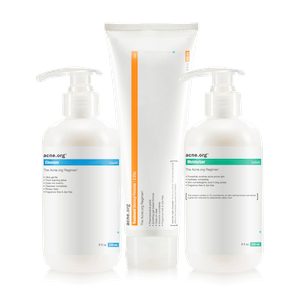 Acne.org Products
Acne.org Products